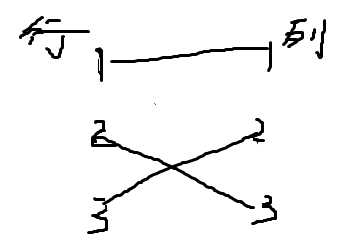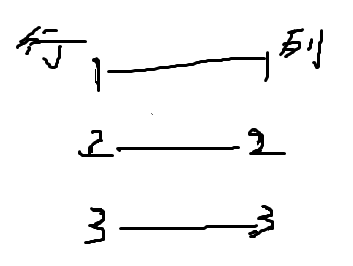Given an N*N matrix with each entry equal to 0 or 1. You can swap any two rows or any two columns. Can you find a way to make all the diagonal entries equal to 1?
InputThere are several test cases in the input. The first line of each test case is an integer N (1 <= N <= 100). Then N lines follow, each contains N numbers (0 or 1), separating by space, indicating the N*N matrix.OutputFor each test case, the first line contain the number of swaps M. Then M lines follow, whose format is “R a b” or “C a b”, indicating swapping the row a and row b, or swapping the column a and column b. (1 <= a, b <= N). Any correct answer will be accepted, but M should be more than 1000.
If it is impossible to make all the diagonal entries equal to 1, output only one one containing “-1”.
Sample Input
2 0 1 1 0 2 1 0 1 0
Sample Output
1 R 1 2 -1
题意:给你一个n*n的棋盘,值都是0或1,你可以任意交换两行两列,不要求最少步数,交换的结果让对角线都为1
思路:首先我们可以看出如果可以交换出结果,只依靠行交换或者列交换即可,然后我们要求的是一条对角线,意思是每列匹配的位置必须是固定的行,
我们把行当做二分图的左边,列当做二分图的右边,1的时候就是行和列直接有一条边,
-1问题我们直接用匈牙利算法求出,求出最大匹配是否是n,如果不是的话,说明有些行还没有匹配,所以不符合要求,如果最大匹配是n的话
我们可以去找属于自己的列,如图

说明满足第一行的匹配在第二列,但是我现在匹配的是第三列,这个时候就要把这两列交换一下,得到以下结果

这个时候第二行匹配错了,所以2,3行交换,然后得到的结果就匹配完成了

#include<cstdio> #include<cmath> #include<cstring> #include<algorithm> using namespace std; struct sss { int x,y; }a[10000]; int n; int mp[101][101]; int vis[101]; int girl[101]; int dfs(int x) { for(int i=1;i<=n;i++) { if(mp[x][i]&&vis[i]==0) { vis[i]=1; if(girl[i]==0||dfs(girl[i])) { girl[i]=x; return 1; } } } return 0; } int main() { while(scanf("%d",&n)!=EOF) { memset(girl,0,sizeof(girl)); for(int i=1;i<=n;i++) { for(int j=1;j<=n;j++) scanf("%d",&mp[i][j]); } int sum=0; for(int i=1;i<=n;i++) { memset(vis,0,sizeof(vis)); sum+=dfs(i); } if(sum!=n) printf("-1 ");//看是否满足全部匹配到了 else{ int num=0; for(int i=1;i<=n;i++) { if(i!=girl[i])//灵活利用girl数组记录了匹配的行 { for(int j=i+1;j<=n;j++)//如果当前行匹配出错,找出需要匹配的行在哪里 { if(i==girl[j]) { int t; t=girl[i]; girl[i]=girl[j]; girl[j]=t; a[num].x=i; a[num].y=j; num++; break; } } } } printf("%d ",num); for(int i=0;i<num;i++) { printf("C %d %d ",a[i].x,a[i].y); } } } }